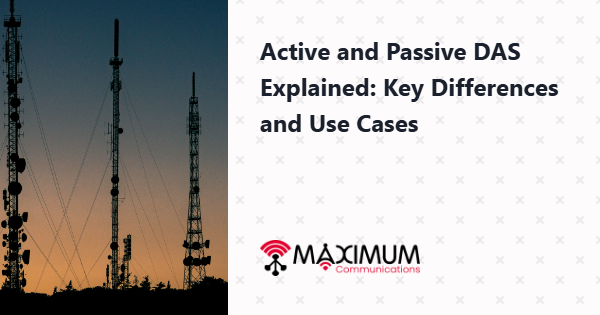DAS (Distributed Antenna Systems) are one of the best options for enhancing indoor cell signal. However, not all DAS are created equal. Active DAS and Passive DAS are the two most common types. Selecting the best one for your building can be made easier if you are aware of the differences between them. Let’s simplify and make it clear.
What is a distributed antenna system, or DAS?
A network of antennas called a Distributed Antenna System (DAS) helps increase cellular coverage inside buildings. It generates its own signals from its equipment or uses cables and antennas to disperse an existing signal from the outside evenly. DAS is especially useful in areas with significant metal walls that block signals, underground areas like parking lots or basements, and large buildings like offices, hospitals, and airports.
For professional DAS system installation, it’s essential to work with experts who understand your building’s unique layout and signal needs.
What is Passive DAS?
A passive DAS is a system that transmits the signal throughout the building using passive antennas, splitters, and coaxial cables.
How It Works:
- To receive cellular signals from outside, a donor antenna is mounted on the roof..
- The coaxial cables carry the signal to a signal booster which is also known as a repeate.
- Then finally the indoor antennas receive the amplified signal and disperse it throughout the building.
Best Use Cases for passive DAS
- When your buildings under 100,000 sq. ft.
- You are at a location with good outdoor signal
- You have small to medium sized offices, retail stores or schools
Pros of Passive DAS
- It is very Cost Effective
- It is Easier to Install
- You have no need for Fiber Cabling
Cons
- It is not ideal for very large or multi carrier environments
- The signal strength depends on donor antenna quality
If you’re looking for expert BDA system installation, Passive DAS may be a perfect fit depending on your building’s size and outdoor signal strength.

What Is an Active DAS?
An Active DAS uses fiber optic cables and digital equipment to distribute signal. Instead of just boosting an outside signal. it can also create a strong signal from scratch (usually by connecting directly to a carrier’s base station).
How it works:
- The system connects to a Baseband Unit (BBU) or carrier signal source
- The digital signal travels over fiber optics to remote units (RUs) around the building
- These RUs convert the signal to RF and send it to indoor antennas
Best Use Cases for Active DAS:
- When your building Over 100,000 sq. ft.
- At hospitals, airports, stadiums, and skyscrapers
- Areas needing support for multiple carriers (AT&T, Verzion, T-Mobile)
Pros of Active DAS
- It works well in very large buildings
- It supports high user capacity
- It is future ready (can be scaled and upgraded)
Cons
- It is more Expensive
- It takes longer installation time
- It usually requires carrier approval or involvement
For compliance and communication in critical buildings, ERCES installation services ensure first responder connectivity and code adherence alongside DAS.
| Feature | Passive DAS | Active DAS |
| Signal Source | Outdoor antenna + booster | Direct from carrier/base station |
| Cable Type | Coaxial | Fiber optic |
| Cost | Lower | Higher |
| Installation Complexity | Easier | Complex |
| Best For | Small to medium buildings | Large/complex buildings |
| Carrier Support | Limited | Multi-carrier, high traffic support |
Choosing the Right DAS for Your Building
When deciding between Active and Passive DAS, consider:
- Size of your building
- Number of users
- Signal strength outside
- Budget
- Carrier requirements
If you just need basic signal improvement in a small space, Passive DAS is a great start. But if you manage a large commercial building or need carrier grade coverage, then Active DAS is the way to go.
Final Thoughts
Both Active and Passive DAS improve cell service indoors, but they work in very different ways. Choosing the right one depends on your building’s needs, your budget, and your signal goals. Either way, improving indoor coverage is not just convenient, it’s becoming a safety requirement in many states. Need help figuring out which DAS system is right for you? Talk to an expert today.
Still unsure which solution suits your property? Let our experts guide you through the best DAS system installation tailored to your unique requirements.








